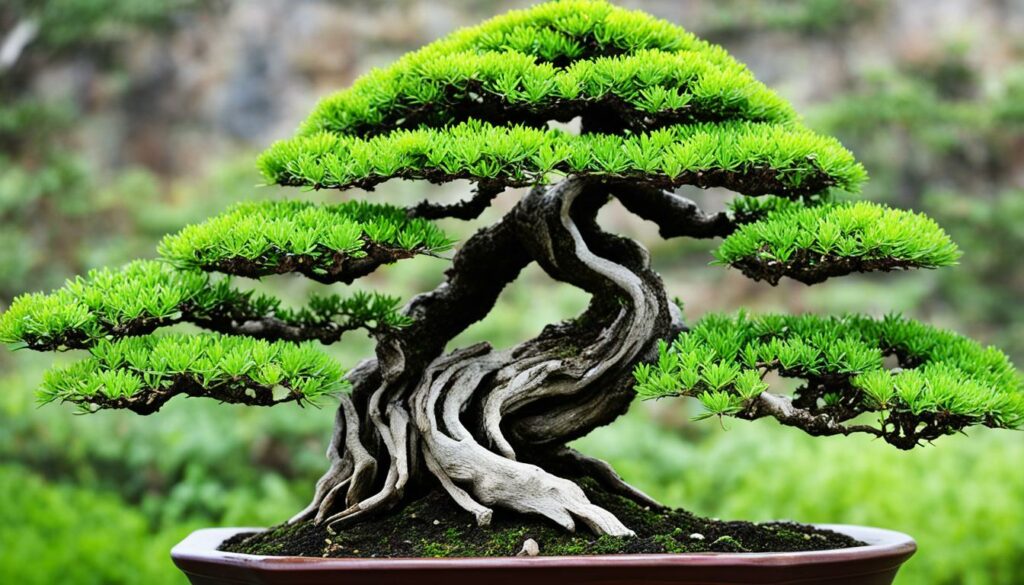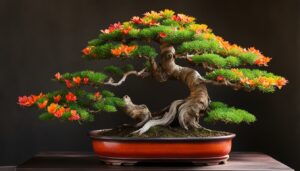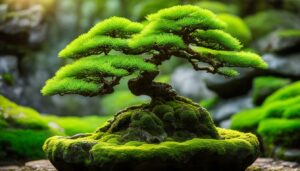If you’re looking to take your bonsai tree styling to the next level, you need to choose the right pot to complement its beauty. Your pot selection is more than just about aesthetics – it plays a crucial role in the health and development of your bonsai. With so many pot styles and options available, it can be overwhelming to make the right choice for your bonsai. But don’t worry, we’ve got you covered.
In this article, we will explore the art of bonsai styling pot selection and provide you with tips to select the perfect pot for your bonsai. We will walk you through various pot styles, how to achieve aesthetic harmony, and what factors to consider when selecting the right container for your bonsai.
Key Takeaways:
- Choosing the right pot plays a crucial role in enhancing the beauty of your bonsai.
- There are various pot styles to choose from, including traditional and modern designs.
- Selecting the perfect pot goes beyond aesthetics; factors such as size, shape, color, and material need to be taken into consideration.
- Matching the pot size to your bonsai’s needs is essential for its overall well-being.
- Proper drainage and airflow are crucial to ensure the health of your bonsai in its new pot.
Understanding the Role of Bonsai Pot Styles
Choosing the right pot for your bonsai is crucial to achieving perfect aesthetic harmony. Bonsai pot styles vary, each offering a unique visual impact, and by understanding them, you can make a more informed decision when selecting a pot for your bonsai.
Traditional pot styles are inspired by the rich history and culture of bonsai and often feature classic design elements that have a timeless appeal. Some examples include the round-shaped Yokkaichi banko and the unglazed Shigaraki.
Modern and contemporary bonsai pot styles offer a fresh take on traditional designs, adding a touch of sophistication and elegance to your bonsai. For instance, the modern Japanese potter Kouichi Hoshi’s work features bold, angular shapes and intricate textures.
Whether you opt for a traditional or modern pot style, it’s essential to consider various factors such as size, shape, material, color, and other essential elements that can enhance your bonsai’s visual impact. So, take your time and explore the different options available to you.
Traditional Bonsai Pot Styles
Traditional bonsai pot styles have been passed down through generations and reflect the rich history and culture of bonsai. These pots are crafted with precise design elements to enhance the natural beauty of the bonsai, with traditional materials such as ceramic, clay, or stone. One of the most popular traditional pot styles is the Yixing pot, originating from China, known for its unique material with porous characteristics that promote healthy airflow and retention of moisture. Other traditional styles include the Tokoname and Bizen pots, popular in Japan, known for their simple shapes and earthy tones
The iconic bonsai cascade style pairs perfectly with the Yokkaichi and Wadatsumi pot styles. The classical and symmetrical design of the bonsai formal upright style is well-suited for a rectangular pot. Traditional bonsai pot styles can enhance the overall beauty and harmonize the bonsai with its surroundings, creating a timeless and sophisticated display.
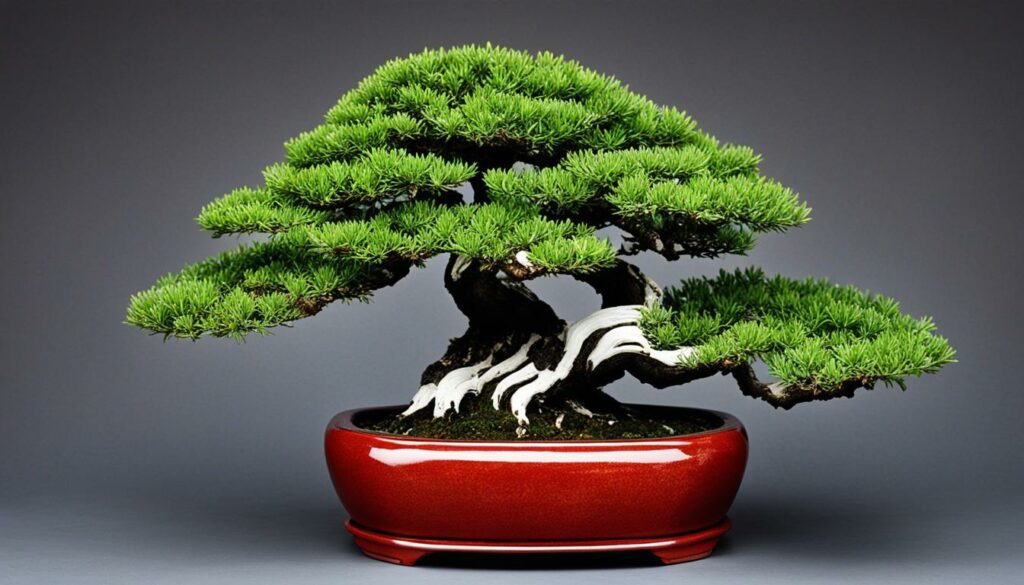
The traditional bonsai pot styles reflect the true essence of bonsai, showcasing the artistry and beauty of nature.
Modern and Contemporary Bonsai Pot Styles
While traditional bonsai pot styles have their charm, modern and contemporary designs offer unique twists on classic designs that can elevate your bonsai’s visual appeal. These pots often showcase sleek lines, unique shapes, and cutting-edge designs that stand out from the crowd. Whether you prefer minimalist designs or pots that incorporate bold colors and patterns, you’re sure to find a style that suits your tastes.
One popular option is the “floating pot” design, which features an elevated pot that creates the illusion of the bonsai tree floating in the air. This design is perfect for showcasing your bonsai’s elegant trunk and roots.
Another contemporary design is the use of unconventional materials, such as metal or glass. These pots offer a sleek, modern look that is perfect for displaying bonsai trees with strong, refined lines.
Example of modern and contemporary bonsai pot styles:
| Bonsai Pot Style | Description | Image |
|---|---|---|
| Minimalist Design | These pots feature clean lines, understated shapes, and neutral colors that highlight the beauty of your bonsai. | |
| Geometric Shapes | These pots showcase striking, angular designs that complement bonsai trees with strong, bold lines. | 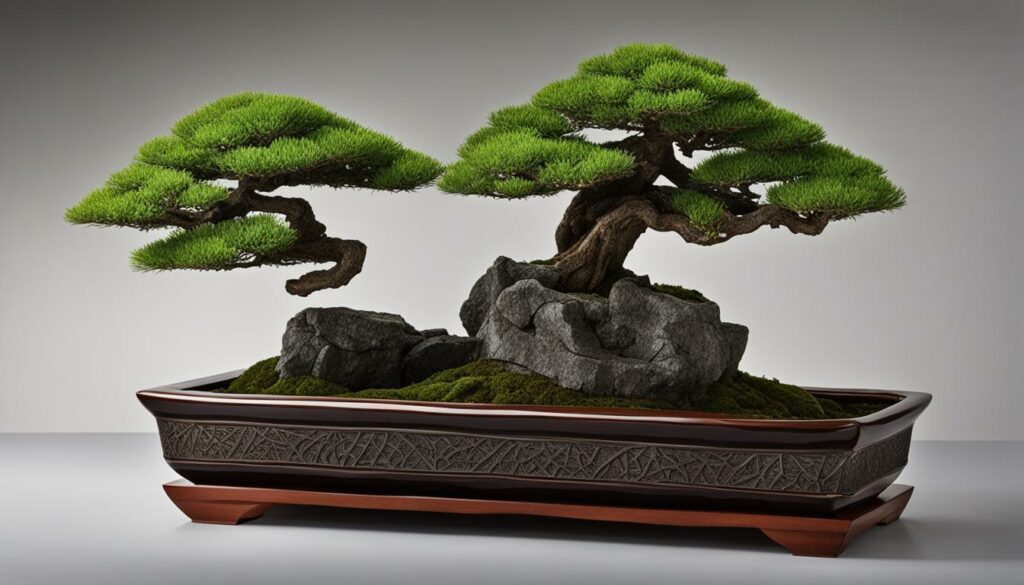 |
| Colorful Patterns | These pots feature intricate designs with bold colors and patterns that add a touch of whimsy and flair to your bonsai display. |
Explore various modern and contemporary bonsai pot styles to find one that perfectly complements your bonsai tree. Remember, the right pot can add sophistication and elegance to your bonsai display and take it to the next level.
Factors to Consider When Choosing a Bonsai Pot
Selecting the right pot for your bonsai is crucial for achieving the perfect aesthetic harmony. Beyond style, there are several important factors to consider when choosing a pot that complements your bonsai and promotes its health. These factors include:
- Size: The pot should be appropriate in size to ensure the roots have enough room to grow, but not too large as to drown the plant in water.
- Shape: The shape should match the natural form of your bonsai, so it doesn’t detract from its beauty and design.
- Color: The color should create contrast or harmony with your bonsai’s foliage and flowers, depending on your preferences.
- Material: Different materials have different advantages and considerations, from aesthetics to drainage and insulation qualities.
Consider these factors carefully when selecting your bonsai pot to ensure that your tree flourishes both in health and beauty.
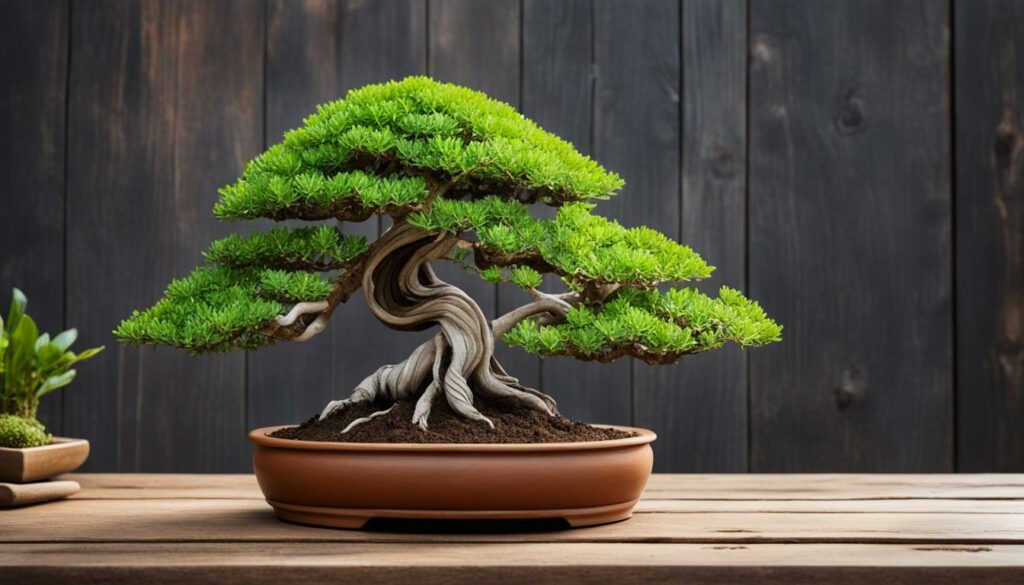
Size Matters: Matching the Pot to Your Bonsai
Choosing the right pot size for your bonsai is crucial for its overall health and development. A pot that’s too small can stunt your bonsai’s growth, while a pot that’s too large can impede its development. Matching the pot size to your bonsai’s needs is essential for its overall well-being.
The appropriate pot size for your bonsai depends on its age and stage of development. When selecting a pot, consider the root system and the height of your bonsai. A general rule of thumb is that the pot should be approximately one-third the height of the tree. However, this varies according to the species.
For instance, a young bonsai tree that’s just starting out should be in a pot that’s smaller than its current root system. This allows the tree to expend energy growing its roots, rather than maintaining branches and foliage. As your bonsai grows, you’ll need to repot it into progressively larger pots to accommodate its root system. A mature bonsai, with a well-established root system, requires a pot with ample room for growth.
Furthermore, the size of the pot can also affect the bonsai’s overall aesthetic appeal. A pot that’s too small can make the tree appear top-heavy, while a pot that’s too large can overpower the tree and detract from its natural form. Choosing the right size pot is essential for achieving the perfect aesthetic harmony.
Embracing the Right Shape: Enhancing Bonsai’s Form
The shape of the pot you choose has a significant impact on your bonsai’s appearance. It can either enhance or detract from the natural form of your bonsai. Choosing the right shape goes beyond just aesthetics, it is essential to create visual harmony with the bonsai’s physical characteristics.
When selecting a pot, consider the overall design of your bonsai. If your bonsai has a tall and slender trunk, it’s best to choose a pot with a narrower opening and taller height. For bonsais with a wider trunk base, the pot should have a broader opening and more shallow depth.
The pot shape should also complement the curve and flow of the branches. A cascading bonsai would look best in a pot with a curved lip, while a bonsai with straight branches would suit a rectangular pot.
“The shape of the pot is as important as the tree it holds. Together, they create a harmonious work of art.”
By embracing the right shape pot selection for your bonsai, you can accentuate its beauty and create visual harmony between the tree and its container.
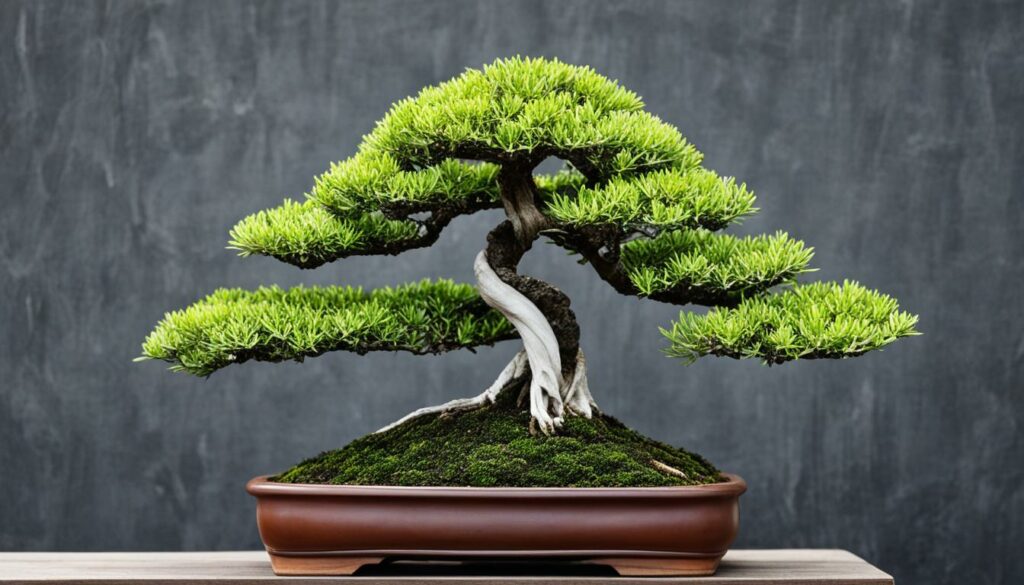
Infusing Color: Coordinating Pot and Foliage
When it comes to selecting a pot for your bonsai, the color of the pot can make a significant impact on the overall aesthetic harmony of your tree. Choosing the right pot color that complements the foliage and flowers of your bonsai can infuse a burst of color and enhance its beauty.
To achieve the perfect color coordination, take cues from the color palette of your bonsai. If your tree has vibrant green foliage, a pot in a complementary color, such as terracotta, brown or beige, can create a pleasing color contrast. Similarly, for a tree with bright red flowers, a green or blue pot can help offset the color beautifully.
It’s important to note that choosing a pot color solely based on your personal preference may not always result in the best aesthetic combination. Using color theory principles, you can determine the right color combination. For instance, complementary colors (colors opposite each other on the color wheel) can create a bold, vibrant effect, while analogous colors (colors adjacent to each other on the color wheel) result in a harmonious blend.
Remember that the pot should not overpower the beauty of your bonsai. Instead, it should enhance the overall appeal, achieve aesthetic harmony, and maintain the focus on your bonsai’s natural form, texture, and color.
Choosing the Right Material: Balance and Functionality
Bonsai pots are available in various materials, including ceramic, clay, plastic, and more. Choosing the right material is a crucial step towards achieving aesthetic harmony and ensuring functionality for your bonsai.
When selecting a pot material, consider factors such as the climate, the pot’s weight, and the size of the bonsai. Ceramic pots, for example, are well suited for outdoor use and provide good insulation, retaining soil moisture. Clay pots, on the other hand, are breathable and encourage airflow to the roots but can be prone to breaking. Plastic pots are lightweight and durable, making them ideal for growing smaller bonsai indoors.
It’s worth noting that the material choice can also impact the visual appeal of your bonsai. Ceramic pots come in various colors and finishes, adding a decorative touch to your bonsai display. Clay pots exude a natural, rustic look that complements certain bonsai styles. Plastic pots may lack the aesthetic appeal of traditional bonsai pots, but they offer a more practical option for maintaining healthy bonsai roots.
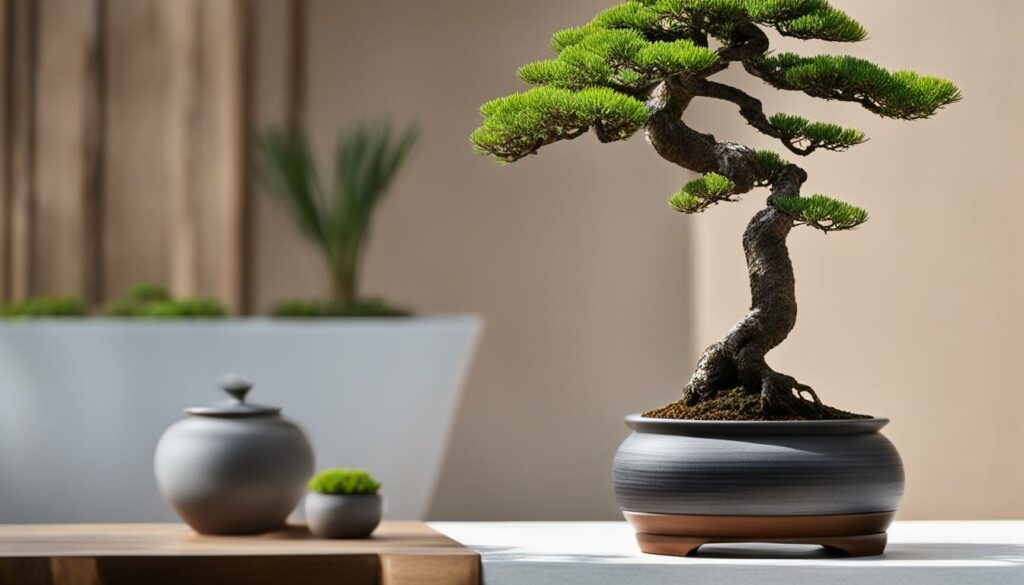
Ultimately, the material you choose should balance both the aesthetic and functional needs of your bonsai. Consider the overall look you want to achieve and the health requirements of your plant. Finding the right material that complements your bonsai and promotes its well-being will ensure that your bonsai thrives for years to come.
Considering Drainage and Airflow: Health of Your Bonsai
When selecting a pot for your bonsai, it’s crucial to consider its drainage and airflow. Improper drainage can lead to waterlogged soil, which can suffocate the roots and cause root rot. On the other hand, insufficient airflow can lead to stagnant air and fungal growth.
To ensure the health of your bonsai, always select a pot that has appropriate drainage holes to allow excess water to exit. The size and number of drainage holes depend on the pot’s size and the type of bonsai. For example, larger pots require more drainage holes to ensure adequate drainage.
Another factor to consider is the pot’s design. Open designs that allow for proper airflow promote healthy root growth and discourage fungal growth.
By selecting a pot with good drainage and airflow, you can provide your bonsai with an environment that fosters healthy growth, which is a crucial aspect of container choice.
Best Practices for Transplanting Your Bonsai
Transplanting your bonsai into a new pot is an essential step in maintaining its health and promoting growth. Here are some best practices to keep in mind when transferring your bonsai to its new container:
- Timing: Late winter or early spring is the ideal time for transplanting, as the bonsai is emerging from dormancy. Avoid transplanting during periods of extreme hot or cold temperatures when your bonsai is more susceptible to stress.
- Selecting a new pot: Carefully choose a new pot that is slightly larger than the current one to allow for growth. Make sure the new pot has appropriate drainage holes and sufficient depth to accommodate the roots.
- Preparing the bonsai: Water your bonsai a day before transplanting to ensure it is hydrated. Gently remove the bonsai from its current pot, being careful not to damage the roots. Use clean, sharp scissors to trim the roots, removing any dead or diseased parts.
- Pruning: Prune back the branches and foliage of your bonsai to reduce potential stress on the roots. Make sure to remove any dead or diseased branches or leaves.
- Add soil: Add a layer of soil to the bottom of the new pot and place the bonsai in the center, making sure the roots are spread evenly. Continue to add soil around the root ball, gently press down to remove any air pockets.
- Water: Water the bonsai thoroughly and place it in a location with appropriate light and temperature.
“Transplanting your bonsai into a new pot can be stressful for the tree, so it’s essential to take proper precautions to minimize this stress. Following these best practices will help ensure your bonsai flourishes in its new container.”
Caring for Your Bonsai in its New Pot
After selecting and transplanting your bonsai into its new pot, proper care is crucial to ensure its well-being. To maximize the beauty and longevity of your bonsai, you must take the necessary steps to keep it healthy and thriving.
Watering Your Bonsai
The key to watering your bonsai is ensuring it gets enough water without overwatering, which can damage the roots. Your soil type, pot size, and tree species determine the frequency of watering. As a general rule, do not water your bonsai on a schedule but observe its soil conditions. When the soil is slightly dry to touch, it is time to water.
Tip: To avoid overwatering, use a moisture meter to check the soil’s moisture level.
Fertilizing Your Bonsai
Fertilizer is essential for bonsai care as it provides the necessary nutrients for growth and development. Choose a quality fertilizer that suits the needs of your tree species, follow the recommended instructions on the package, and apply it during the growing season. Do not fertilize your bonsai during dormant seasons.
Tip: To avoid over-fertilization, use the recommended dosage of fertilizer and avoid applying it too close to the trunk.
Maintaining the Health of Your Bonsai
Bonsai requires regular maintenance to preserve its health and prevent pests and diseases. Inspect your bonsai regularly for signs of damage, pests, or diseases and take the necessary action immediately. Prune your bonsai regularly to manage its growth and maintain its shape.
Tip: Keep your bonsai in good health by placing it in a location with ample light, avoiding extreme temperatures, and providing it with adequate airflow.
“Caring for your bonsai requires dedication and attention to detail. With proper watering, fertilizing, and maintenance, your bonsai will thrive in its new pot and grace your home with its beauty.”
Showcasing Bonsai: Display and Pot Selection
When it comes to displaying your bonsai, pot selection plays a crucial role in creating aesthetic harmony. Whether you’re creating a formal display or a relaxed and casual atmosphere, the right pot can enhance your bonsai’s natural beauty and create a visually appealing setting.
To select the perfect pot for showcasing your bonsai, consider the style of your plant, its size, and the overall design of your display. Your container choice should harmonize with the colors, shapes, and textures of your bonsai and highlight its unique characteristics.
For a formal display, choose a pot that complements the style of your bonsai. Traditional styles are best suited for upright or cascading bonsai, while modern pots can provide a touch of sophistication to your display. You can also consider adding accent pieces such as rocks or figurines to complete the look.
If you’re creating a more relaxed display, you can choose a pot that creates a natural and harmonious atmosphere. Consider using a shallow pot for a cascading bonsai, or a deeper container for an upright style. Don’t be afraid to experiment with different pot styles until you find one that suits your taste and complements your bonsai.
Remember, the ultimate goal of displaying your bonsai is to enhance its beauty. Therefore, selecting the right pot should always prioritize aesthetic harmony and complement your container. With the right pot, you can create a breathtaking display that showcases your bonsai’s natural beauty and artistic appeal.
Choosing the Perfect Bonsai Pot for Different Bonsai Styles
When it comes to bonsai pot selection, different bonsai styles require different container choices. Understanding the relationship between bonsai style and pot style is crucial for achieving aesthetic harmony.
For formal upright bonsai styles, the pot should be oval or rectangular in shape. This will complement the tree’s straight trunk and symmetrical branches. Earth-toned colors, such as browns and greens, are an excellent choice for these styles.
For cascade and semi-cascade styles, the pot should be deeper than it is wide. This will allow the tree to hang over the edge of the container, creating a striking visual effect. Brightly colored pots, such as blues and oranges, can add a pop of color to these styles.
For windswept bonsai styles, the pot should be angled in a way that complements the tree’s slanted trunk. The container’s shape should match the slant of the tree, creating the illusion of movement. Neutral colors, such as grays and tans, can add a touch of elegance to these styles.
When choosing a pot for bonsai forest styles, opt for large and shallow trays that can hold multiple trees. The pot’s color and design should complement the foliage of the trees, creating a cohesive and beautiful display.
Choosing the Perfect Bonsai Pot Table
| Bonsai Style | Pot Style | Pot Color |
|---|---|---|
| Formal Upright | Oval or rectangular | Earth-toned colors, such as browns and greens |
| Cascade and Semi-cascade | Deep pot | Bright colors, such as blues and oranges |
| Windswept | Slanted pot | Neutral colors, such as grays and tans |
| Bonsai Forest | Large, shallow tray | Complementary to foliage colors |
To sum up, choosing the perfect pot for your bonsai style is crucial for achieving aesthetic harmony. Take into consideration the shape, color, and design of the pot, ensuring that it complements and enhances the beauty of your tree. Follow these guidelines, and your bonsai will thrive in its new home.
Avoiding Common Mistakes in Bonsai Pot Selection
Selecting the wrong pot can detract from the beauty of your bonsai. Here are some common mistakes to avoid:
- Ignoring pot styles: Bonsai pot styles can significantly impact the overall aesthetic appeal of your bonsai. Avoid choosing a pot that clashes with your bonsai’s style or form.
- Forgetting about aesthetic harmony: Consider how the pot’s size, shape, color, and material will harmonize with your bonsai’s foliage and natural form.
- Choosing the wrong container size: Picking a pot that is too small or too large can hinder the growth and development of your bonsai.
- Ignoring drainage and airflow: Poor drainage and airflow can lead to root rot and other health issues. Choose a pot with adequate drainage and an open design that promotes proper airflow.
- Overlooking material considerations: Each pot material, including ceramic, clay, and plastic, has unique advantages and considerations. Consider aesthetics and functionality when choosing a pot material.
By avoiding these common mistakes, you can select a pot that enhances the beauty and impact of your bonsai.
Conclusion
Choosing the right pot for your bonsai is essential for achieving the perfect aesthetic harmony. By understanding pot styles and considering factors such as size, shape, color, material, drainage, and airflow, you can elevate the beauty of your bonsai. Remember to prioritize the health and development of your bonsai when selecting the right pot.
Transplanting your bonsai into a new pot requires care and technique to minimize stress and promote healthy growth. Once your bonsai is in its new pot, proper care is crucial to maximize its beauty and longevity.
Displaying your bonsai is an art, and pot selection plays a vital role in showcasing its beauty. Different bonsai styles have unique requirements when it comes to pot selection, so understanding this relationship is crucial for achieving overall aesthetic harmony. Avoid common mistakes in bonsai pot selection to enhance your bonsai’s visual impact.
With the right pot, your bonsai will become a stunning centerpiece in your collection. Keep these tips in mind to enhance the beauty and health of your bonsai for years to come.
FAQ
How important is it to choose the right pot for my bonsai?
Choosing the right pot is crucial for enhancing the beauty of your bonsai and achieving aesthetic harmony. The pot you select can significantly impact the overall appearance and visual appeal of your bonsai tree.
What are the different pot styles available for bonsai trees?
Bonsai pot styles vary, offering a range of visual impacts. Traditional styles are inspired by history and culture, while modern and contemporary styles offer a fresh take on design. Exploring different pot styles can help you make an informed selection.
What are some popular traditional pot styles for bonsai?
Traditional pot styles are inspired by the rich history of bonsai. Some popular options include the round, rectangular, and hexagonal pot styles. Each has its own unique characteristics and timeless appeal.
Are there modern and contemporary pot styles available for bonsai trees?
Yes, there are modern and contemporary pot styles that can add sophistication and elegance to your bonsai. These pots often feature innovative designs and materials, offering a fresh and unique aesthetic for your bonsai tree.
What factors should I consider when choosing a bonsai pot?
When choosing a bonsai pot, consider factors such as size, shape, color, and material. These elements all contribute to achieving aesthetic harmony and ensuring the pot complements your bonsai tree.
How do I determine the appropriate pot size for my bonsai?
The size of the pot is important for the health and development of your bonsai. It should be proportionate to the age and stage of bonsai development. Matching the pot size to your bonsai’s needs is essential for its overall well-being.
Does the shape of the pot matter for my bonsai?
Yes, the shape of the pot can enhance or detract from the natural form of your bonsai. Choose a pot shape that complements your bonsai’s trunk, branches, and overall design. This will accentuate its beauty and create visual harmony.
How does pot color impact the overall aesthetic of my bonsai?
The color of the pot can harmonize or contrast with the foliage and flowers of your bonsai. Consider selecting a pot color that complements the colors present in your bonsai. This infusion of color will elevate the overall aesthetic appeal of your bonsai tree.
What are the different materials available for bonsai pots?
Bonsai pots come in various materials, including ceramic, clay, and plastic. Each material has its own advantages and considerations. Choose a material that balances aesthetics and functionality for your bonsai.
Why is drainage and airflow important for my bonsai pot?
Proper drainage and airflow are essential for the health of your bonsai. Choose pots with appropriate drainage holes and open designs that promote good airflow. These factors will ensure that your bonsai thrives in its new pot.
What are the best practices for transplanting my bonsai to a new pot?
Transplanting your bonsai into a new pot requires careful consideration and technique. Follow best practices for safely transferring your bonsai, minimizing stress on the tree and promoting healthy growth.
How should I care for my bonsai after it’s been transplanted into a new pot?
Once your bonsai is in its new pot, proper care is crucial for its well-being. Follow tips on watering, fertilizing, and maintaining the overall health of your bonsai. Caring for your bonsai correctly will maximize its beauty and longevity.
How does pot selection contribute to showcasing my bonsai?
Pot selection plays a vital role in showcasing your bonsai’s beauty. Whether creating a formal or informal display, choose a pot that complements your bonsai, creating a visually appealing setting that enhances its overall aesthetic.
How do I choose the perfect bonsai pot for different bonsai styles?
Different bonsai styles have unique requirements for pot selection. Choose the perfect pot for various styles such as formal upright, cascade, and windswept, understanding the relationship between style and pot choice for overall aesthetic harmony.
What are some common mistakes to avoid when selecting a bonsai pot?
There are common mistakes that can detract from the beauty and impact of your bonsai. Be aware of these pitfalls and follow tips on how to avoid them, ensuring that you make informed decisions and enhance your bonsai’s visual appeal.
